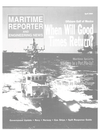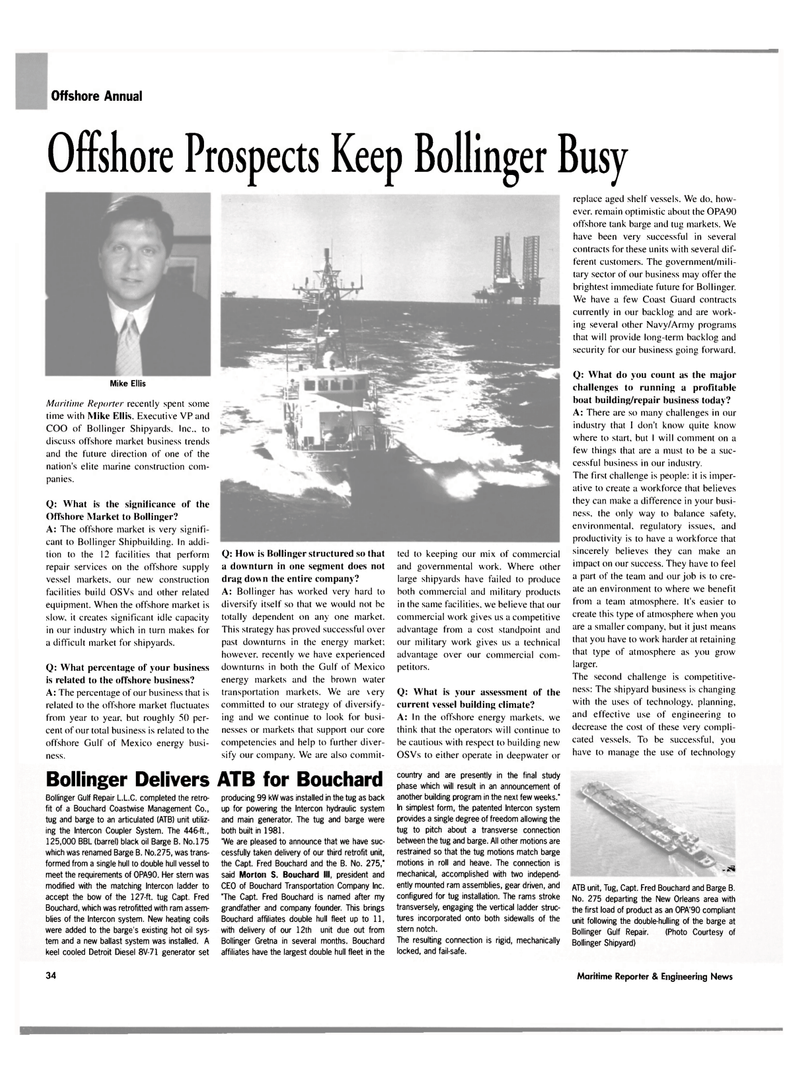
Page 36: of Maritime Reporter Magazine (April 2004)
Offshore Technology Yearbook
Read this page in Pdf, Flash or Html5 edition of April 2004 Maritime Reporter Magazine
Offshore Annual
Offshore Prospects Keep Bollinger Busy
Mike Ellis
Maritime Reporter recently spent some time with Mike Ellis. Executive VP and
COO of Bollinger Shipyards. Inc.. to discuss offshore market business trends and the future direction of one of the nation's elite marine construction com- panies.
Q: What is the significance of the
Offshore Market to Bollinger?
A: The offshore market is very signifi- cant to Bollinger Shipbuilding. In addi- tion to the 12 facilities that perform repair services on the offshore supply vessel markets, our new construction facilities build OSVs and other related equipment. When the offshore market is slow, it creates significant idle capacity in our industry which in turn makes for a difficult market for shipyards.
Q: What percentage of your business is related to the offshore business?
A: The percentage of our business that is related to the offshore market fluctuates from year to year, but roughly 50 per- cent of our total business is related to the offshore Gulf of Mexico energy busi- ness.
Q: How is Bollinger structured so that a downturn in one segment does not drag down the entire company?
A: Bollinger has worked very hard to diversify itself so that we would not be totally dependent on any one market.
This strategy has proved successful over past downturns in the energy market: however, recently we have experienced downturns in both the Gulf of Mexico energy markets and the brown water transportation markets. We are very committed to our strategy of diversify- ing and we continue to look for busi- nesses or markets that support our core competencies and help to further diver- sify our company. We are also commit-
Bollinger Delivers ATB for Bouchard
Bollinger Gulf Repair L.L.C. completed the retro- fit of a Bouchard Coastwise Management Co., tug and barge to an articulated (ATB) unit utiliz- ing the Intercon Coupler System. The 446-ft., 125,000 BBL (barrel) black oil Barge B. No.175 which was renamed Barge B. No.275, was trans- formed from a single hull to double hull vessel to meet the requirements of OPA90. Her stern was modified with the matching Intercon ladder to accept the bow of the 127-ft. tug Capt. Fred
Bouchard, which was retrofitted with ram assem- blies of the Intercon system. New heating coils were added to the barge's existing hot oil sys- tem and a new ballast system was installed. A keel cooled Detroit Diesel 8V-71 generator set producing 99 kW was installed in the tug as back up for powering the Intercon hydraulic system and main generator. The tug and barge were both built in 1981. "We are pleased to announce that we have suc- cessfully taken delivery of our third retrofit unit, the Capt. Fred Bouchard and the B. No. 21b," said Morton S. Bouchard III, president and
CEO of Bouchard Transportation Company Inc. "The Capt. Fred Bouchard is named after my grandfather and company founder. This brings
Bouchard affiliates double hull fleet up to 11, with delivery of our 12th unit due out from
Bollinger Gretna in several months. Bouchard affiliates have the largest double hull fleet in the ted to keeping our mix of commercial and governmental work. Where other large shipyards have failed to produce both commercial and military products in the same facilities, we believe that our commercial work gives us a competitive advantage from a cost standpoint and our military work gives us a technical advantage over our commercial com- petitors.
Q: What is your assessment of the current vessel building climate?
A: In the offshore energy markets, we think that the operators will continue to be cautious with respect to building new
OSVs to either operate in deepwater or country and are presently in the final study phase which will result in an announcement of another building program in the next few weeks."
In simplest form, the patented Intercon system provides a single degree of freedom allowing the tug to pitch about a transverse connection between the tug and barge. All other motions are restrained so that the tug motions match barge motions in roll and heave. The connection is mechanical, accomplished with two independ- ently mounted ram assemblies, gear driven, and configured for tug installation. The rams stroke transversely, engaging the vertical ladder struc- tures incorporated onto both sidewalls of the stern notch.
The resulting connection is rigid, mechanically locked, and fail-safe. replace aged shelf vessels. We do, how- ever. remain optimistic about the OPA90 offshore tank barge and tug markets. We have been very successful in several contracts for these units with several dif- ferent customers. The government/mili- tary sector of our business may offer the brightest immediate future for Bollinger.
We have a few Coast Guard contracts currently in our backlog and are work- ing several other Navy/Army programs that will provide long-term backlog and security for our business going forward.
Q: What do you count as the major challenges to running a profitable boat building/repair business today?
A: There are so many challenges in our industry that 1 don't know quite know where to start, but I will comment on a few things that are a must to be a suc- cessful business in our industry.
The first challenge is people: it is imper- ative to create a workforce that believes they can make a difference in your busi- ness, the only way to balance safety, environmental, regulatory issues, and productivity is to have a workforce that sincerely believes they can make an impact on our success. They have to feel a part of the team and our job is to cre- ate an environment to where we benefit from a team atmosphere. It's easier to create this type of atmosphere when you are a smaller company, but it just means that you have to work harder at retaining that type of atmosphere as you grow larger.
The second challenge is competitive- ness: The shipyard business is changing with the uses of technology, planning, and effective use of engineering to decrease the cost of these very compli- cated vessels. To be successful, you have to manage the use of technology >M
ATB unit, Tug, Capt. Fred Bouchard and Barge B.
No. 275 departing the New Orleans area with the first load of product as an OPA'90 compliant unit following the double-hulling of the barge at
Bollinger Gulf Repair. (Photo Courtesy of
Bollinger Shipyard) 34 Maritime Reporter & Engineering News

 35
35

 37
37
